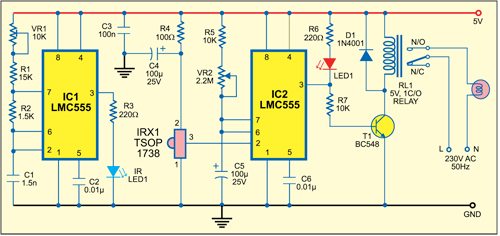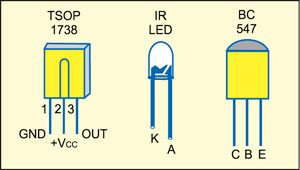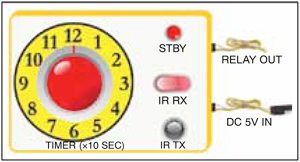 This type of infrared proximity circuit is widely used as an electric switch where physical contact is not desired for hygiene purpose. For example, we commonly see use of infrared proximity sensors on public drinking fountains and in public washrooms. The simple touch free timer switch circuit presented here can be operated by moving your hand in front of it. This is achieved by detecting the infrared light reflected by your hand onto a receiver device.
This type of infrared proximity circuit is widely used as an electric switch where physical contact is not desired for hygiene purpose. For example, we commonly see use of infrared proximity sensors on public drinking fountains and in public washrooms. The simple touch free timer switch circuit presented here can be operated by moving your hand in front of it. This is achieved by detecting the infrared light reflected by your hand onto a receiver device.
Circuit Diagram
Fig. 1 shows the circuit of the touch free timer switch. It has two sections: transmitter and receiver. The IR transmitter is built around timer LMC555 (IC1), which is wired as an astable multivibrator. The multivibrator produces 38kHz pulses (at low duty cycle) that drive an infrared LED (LED1). This frequency can be tuned using a 10-kilo-ohm preset (VR1). A 220-ohm series resistor (R3) ensures that the current consumption of the IR transmitter is not out of arrangement.

The receiver section is built around IR receiver module TSOP1738 (IRX1), timer LMC555 (IC2) and a few discrete components. The TSOP1738 is an integrated miniaturised receiver for infrared remote control systems. Everything required for IR signal processing, including the PIN diode and preamplifier, are assembled on a lead frame and the epoxy package is designed as an IR filter.
Touch free timer switch operation
When a short IR burst is received by IRX1 (as you wave your hand in front of the switch), the demodulated pulses are fed to the trigger input (pin 2) of the second LMC555 (IC2). This, in turn, triggers the monostable wired around IC2 and its output pin 3 goes high for a period determined by the 2.2-mega-ohm potentiometer and capacitor C5. This turns off the standby indicator (LED1) and transistor T1 conducts to drive the 5V relay (RL1). LED1 enables you to locate the switch in the dark. AC mains supply to the load to be switched-on is routed through the pole and normally-opened contacts of RL1 as shown in the diagram. The circuit works off regulated 5V DC.
Fig. 2 shows the pin configurations of TSOP1738, IR LED1 and transistor BC547. Assemble the circuit on a general-purpose PCB and enclose in a small plastic cabinet. Fit IR LED1 with a reflecting hood at a recessed position on the front panel of the enclosure. The dome-shaped face of the TSOP1738 should stick out from the front panel. Fit the time-control potentiometer (VR2) in an appropriate position. Finally, fit the standby indicator LED1 inside a suitable LED holder such that it slightly protrudes from the front panel. To prevent unwanted reflection of the IR beam, the finished unit should be mounted such that it does not face a nearby wall.


Construction & testing
Using high-precision linear potentiometer VR2 and capacitor C5 (100µF), the time length can be set from nearly 1 second to 120 seconds. Attach a small paper dial on the front panel of the enclosure and mark various positions of the control knob of VR2 as shown in Fig. 3. The accuracy of the timer depends mainly upon the quality (and value) of timing capacitor C5. In practice, most electrolytic capacitors are rated on the basis of minimum guaranteed value and the real value may be higher.
The article was originally published in August 2012 and has been recently updated.









In figure 3 please will you explain the terms STBY, IR RX & IR TX!
Is it possible to get the PCB along with other parts?
Can I get this motion sensor circuit PCB with components
I would like to know the importance of the other part of the circuit consisting of the IC1 and the VR1 and the other components and the meaning of RX and TX on figure 3
I just share this because it cost me time to serch for it so you guys don’t
Ic1 is vco voltage control oscillator
Ic1and 1c2 work on like ordinary monostable and astable On principle of charging and discharging . Transistor is to activate relay you must learn about relay then diode is a fly wheel or fly back diode just search for it you will understand you can use ic 556 instead of two 555 ics